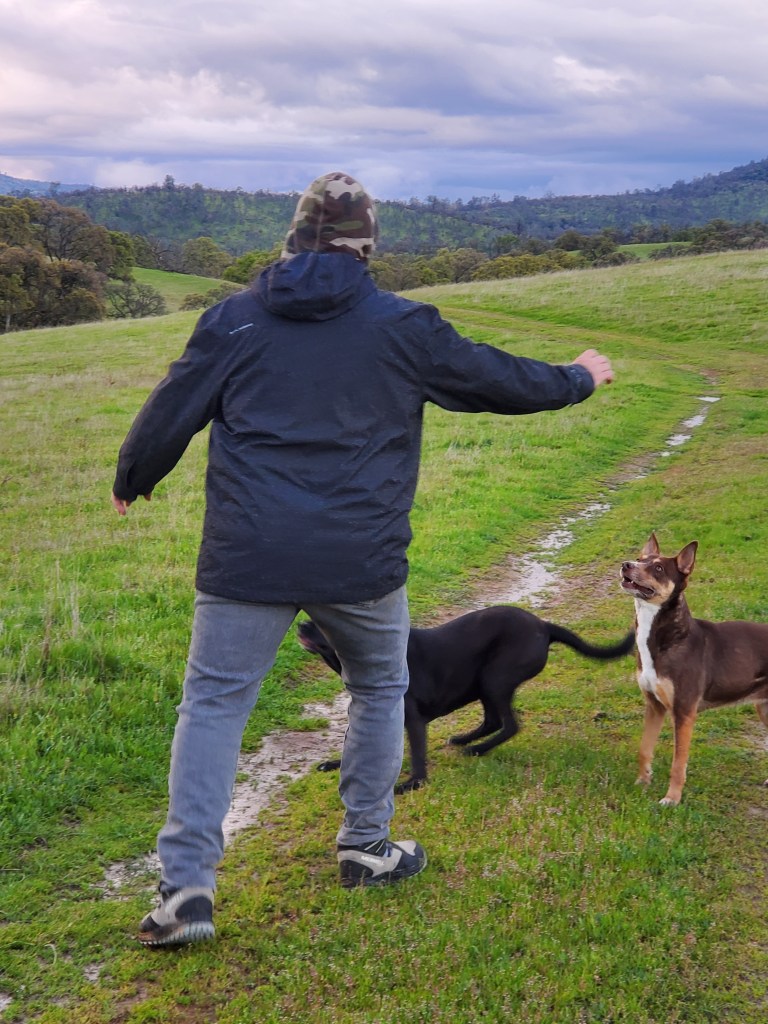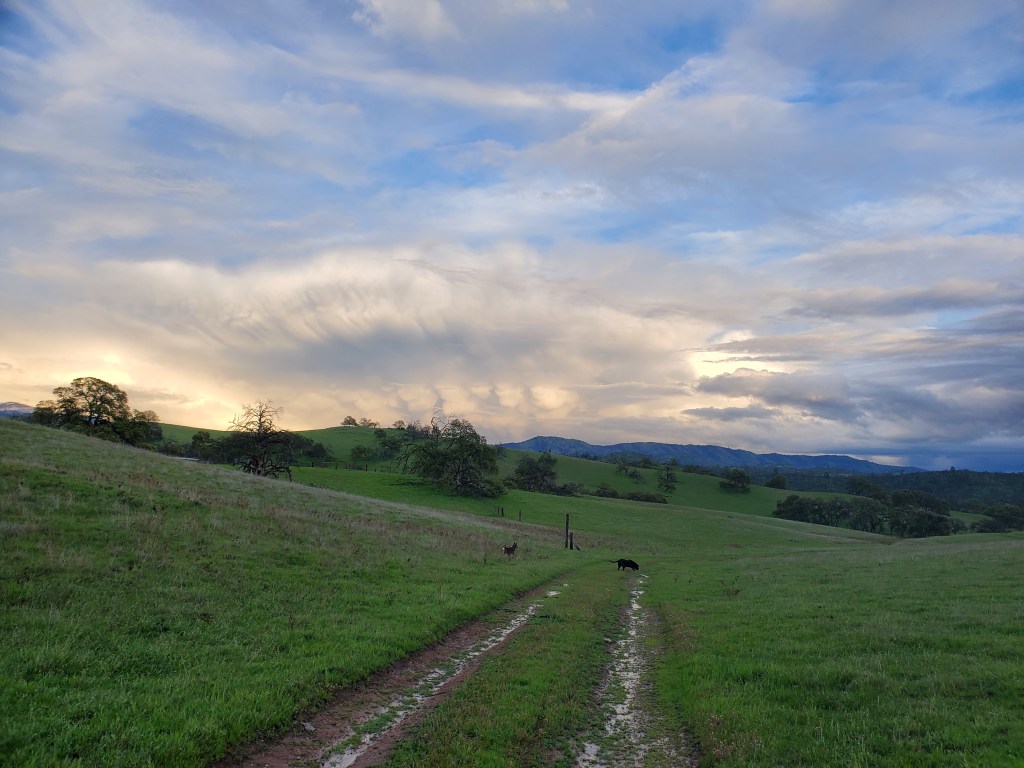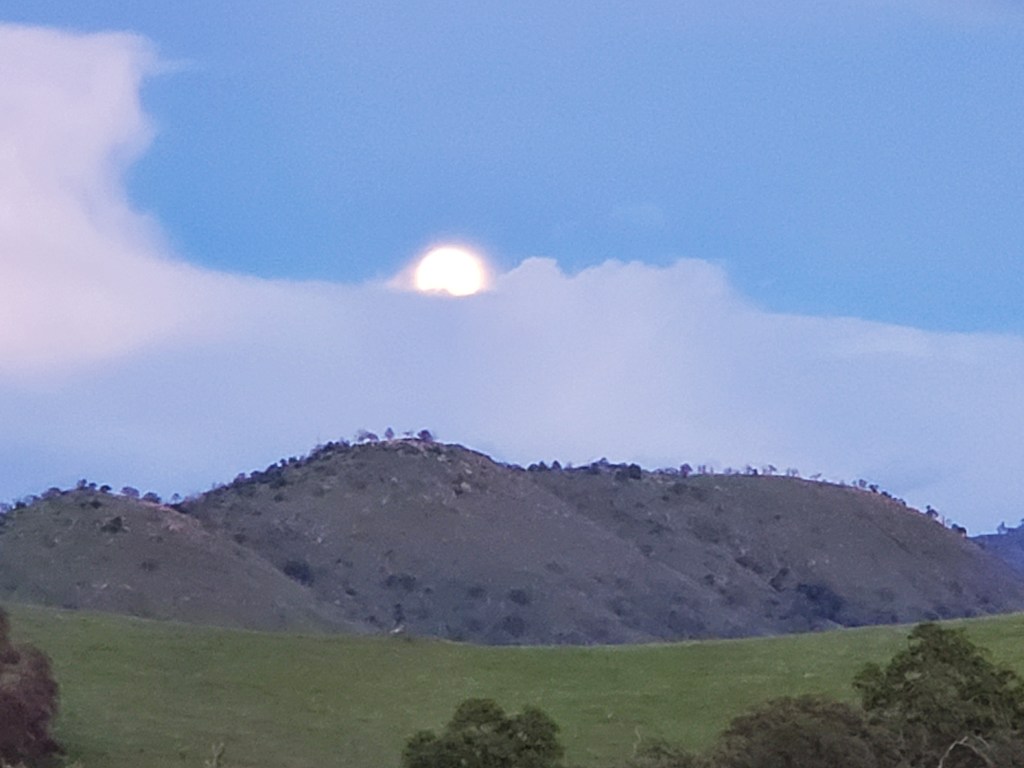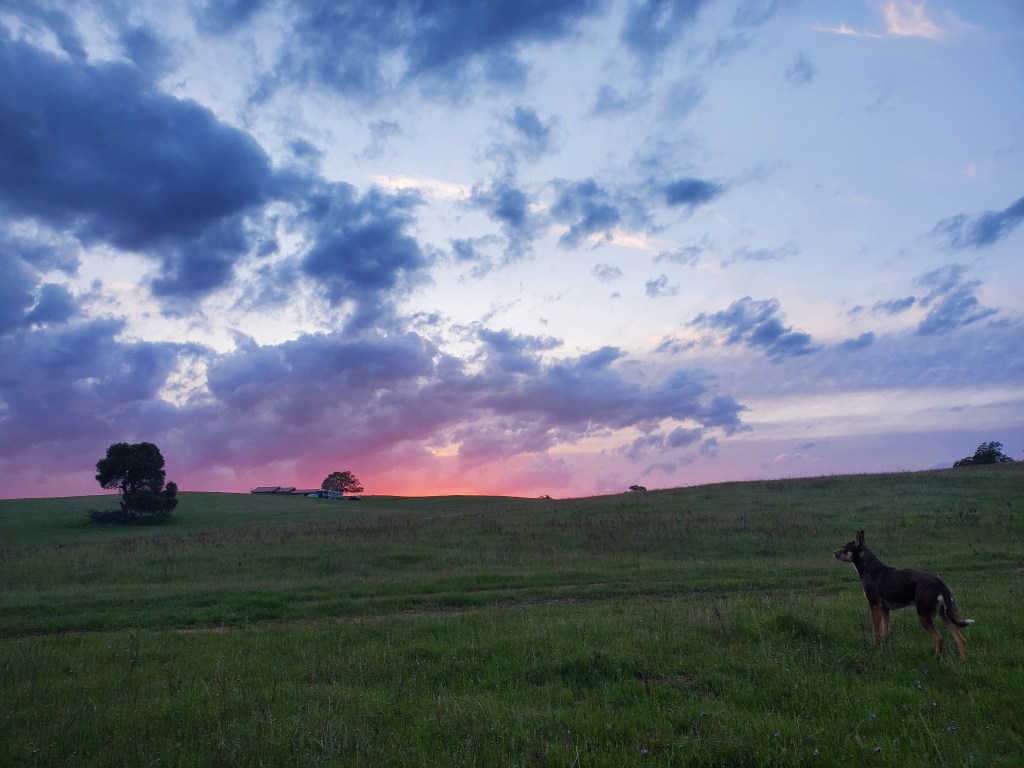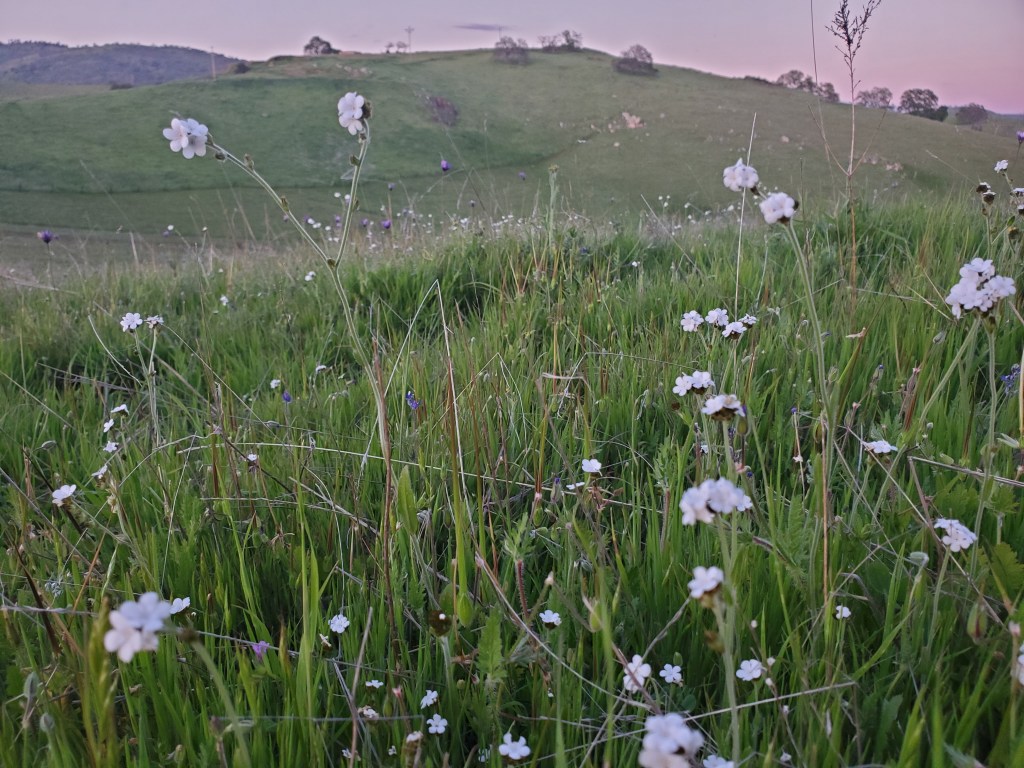
The smell of nectar – that is how I started my previous blog post. It is 10 times as intense now. As I walk, I breath deep, then deeper. I want my all the tissues in my body to remember the scent and oily feel of this sensory gift the plants are giving. They get something too of course – pollination, genetic distribution, a chance to live again next year through their progeny. A life well-lived, whether insect, flower, or mammal, is a life of reciprocity.
Almost daily I make my way up the steep hills to check on the California Milkweed. It has been raining, and I want to see how everything is impacted. I am not entirely sure why, maybe curiosity, for there is very little I can do to help them. Their lives are in nature’s interconnected tendrils, a thatch of inter-dependencies, of which I am just one piece – with agency – but not as effective as I would like.

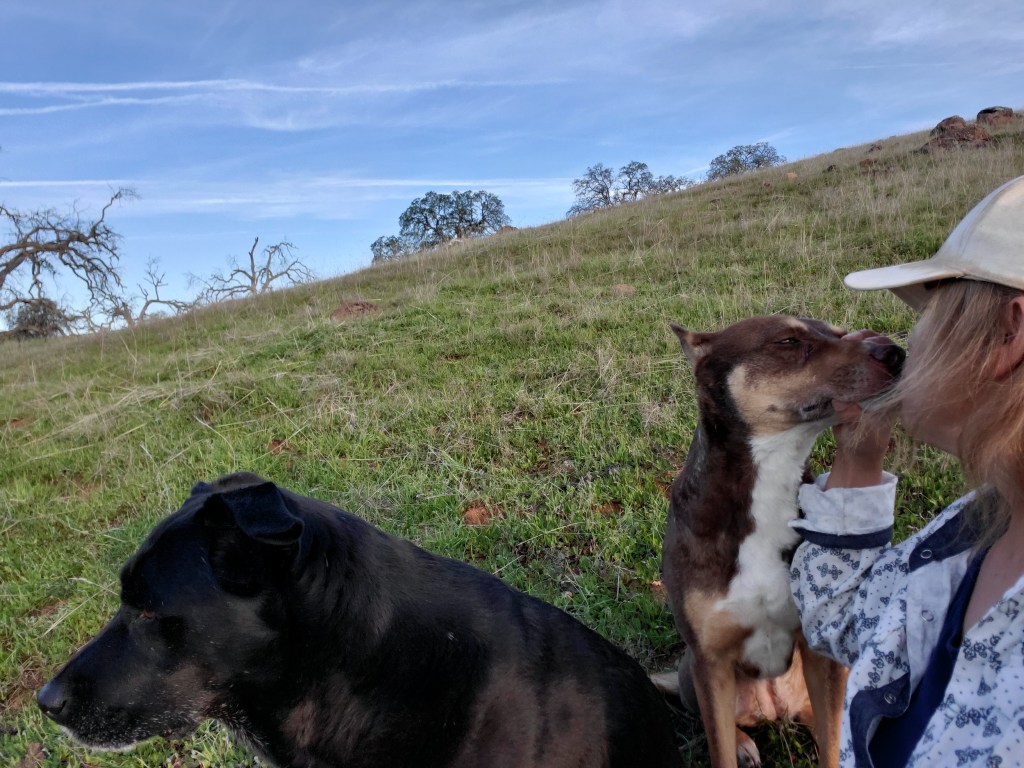
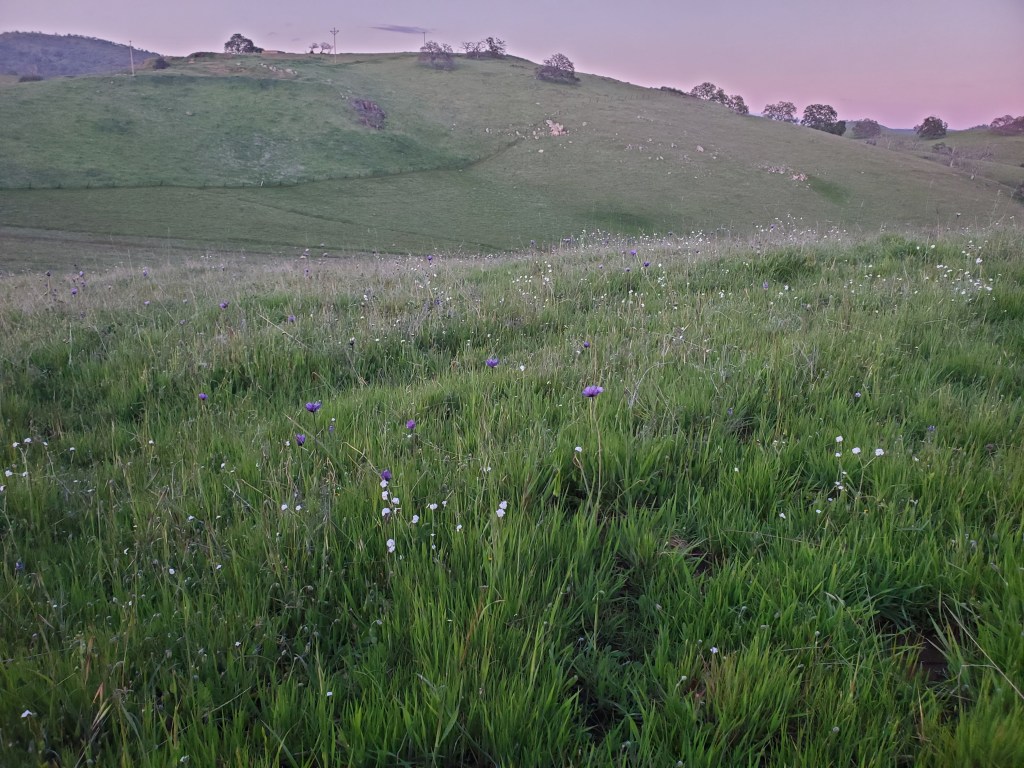
Breathing deep (and labored from the grade), I finally get to my destination, the large community of plants. There are four things that become immediately clear: 1. something has been here before me. The dogs are sniffing tightly around the milkweed. I get nervous. 2. The leaves look a bit rough from moisture, the delicate, velvet-like fuzz drooped just a little, a dusting of white mildew on the body. 3. Flowers are already beginning to bud. It seems early, but what I have learned over the years is that the CA Milkweeds are truth-tellers, future-readers. I imagine them with their crystal balls beckoning me to sit nearby and listen to a reading of the future. The future they are predicting is a spring done early and longer summer. After all, we only had five days of real winter here – only 5 days the ground frosted over. 4. After my typical count, I finally see it. Plants are missing. I move around the space counting again. There were 10 of 17 at site one. Seven of 11 at site two. One of 1 at site three, and 1 of 2 at site four. There were 10 plants here the other day. I am missing two, no three plants, and I see that there is a new one that has emerged – so technically, there should now be 11. The cows were up there just a week before, but there is no sign of browsing, no trail of pulled stems and leaves remaining from an ill-conceived tasting of a bitter, toxic treat. It doesn’t make sense anyway. With all the thick, delicious, moisture-rich grass, there is no compulsion to try something that smells of bitterness. Among the missing is one of the largest, oldest plants. I get on my hands and knees to look closer. I see a hole. The gophers got them. What kind of gophers are these? They like the thick, bitter milk of the milkweed, the dense poison of the root? Before my heart sinks, I see one small leave still there. It’s adjacent leaf is bit off at the stem, but nonetheless one leaf and stem has survived.


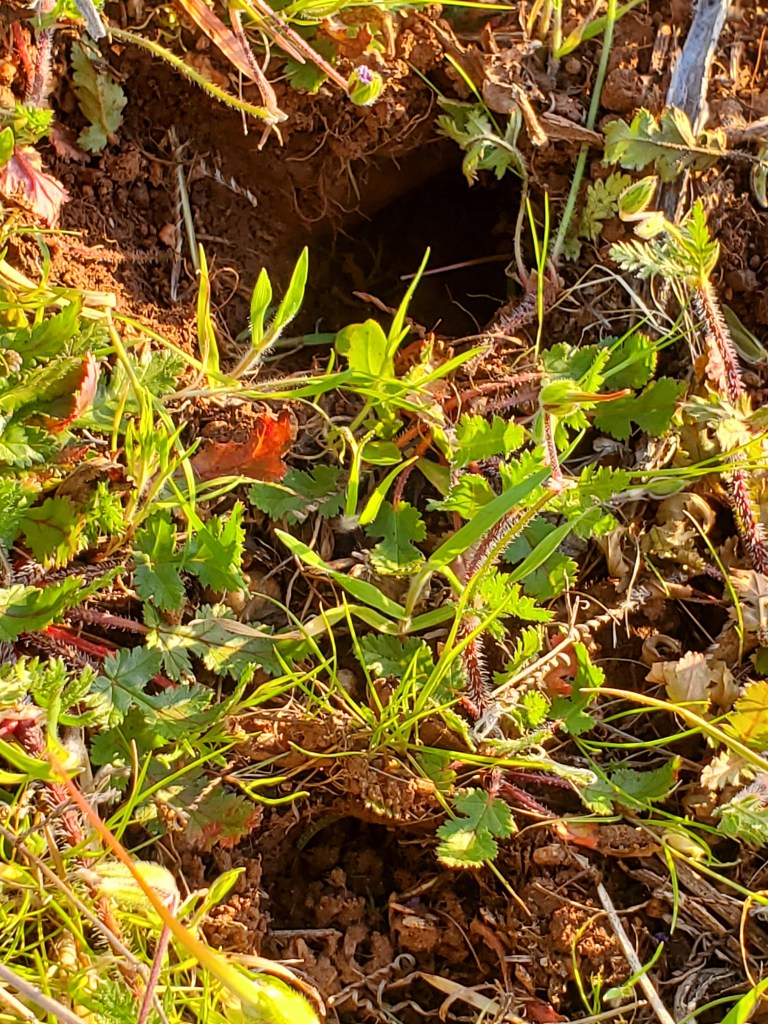

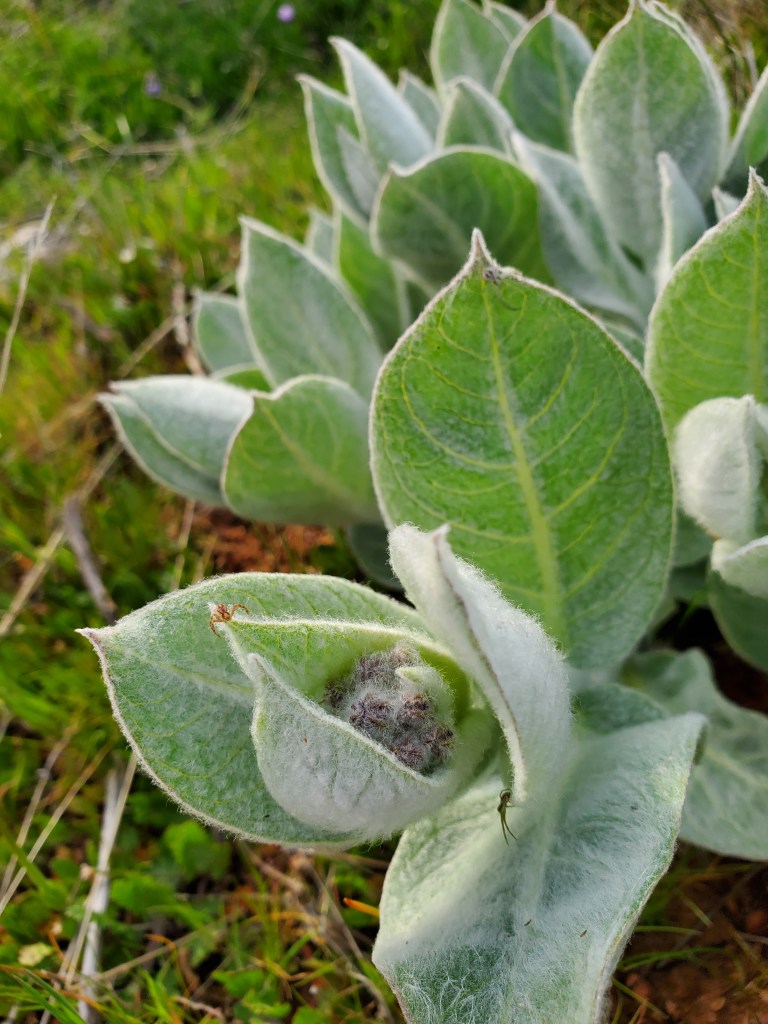
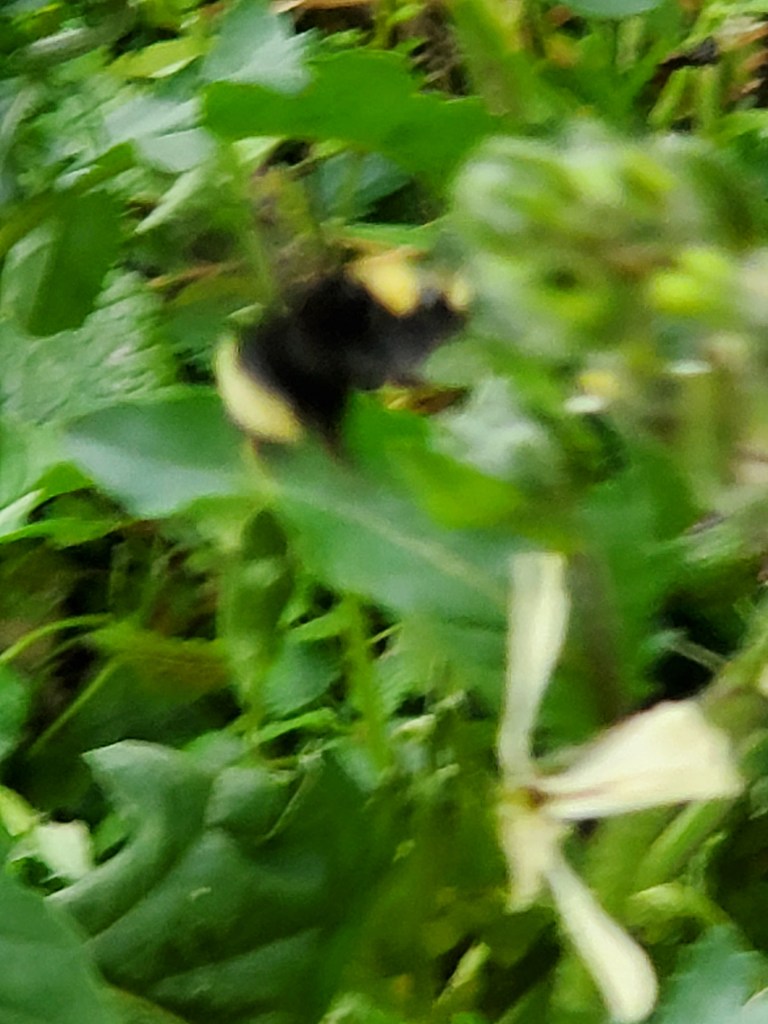
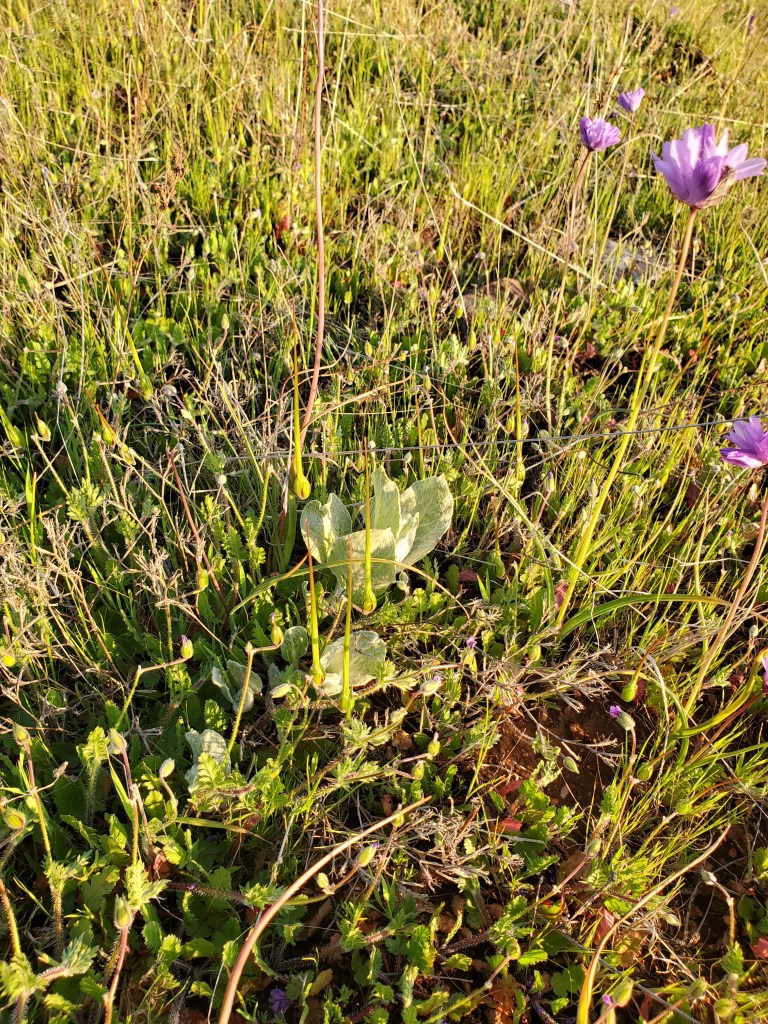
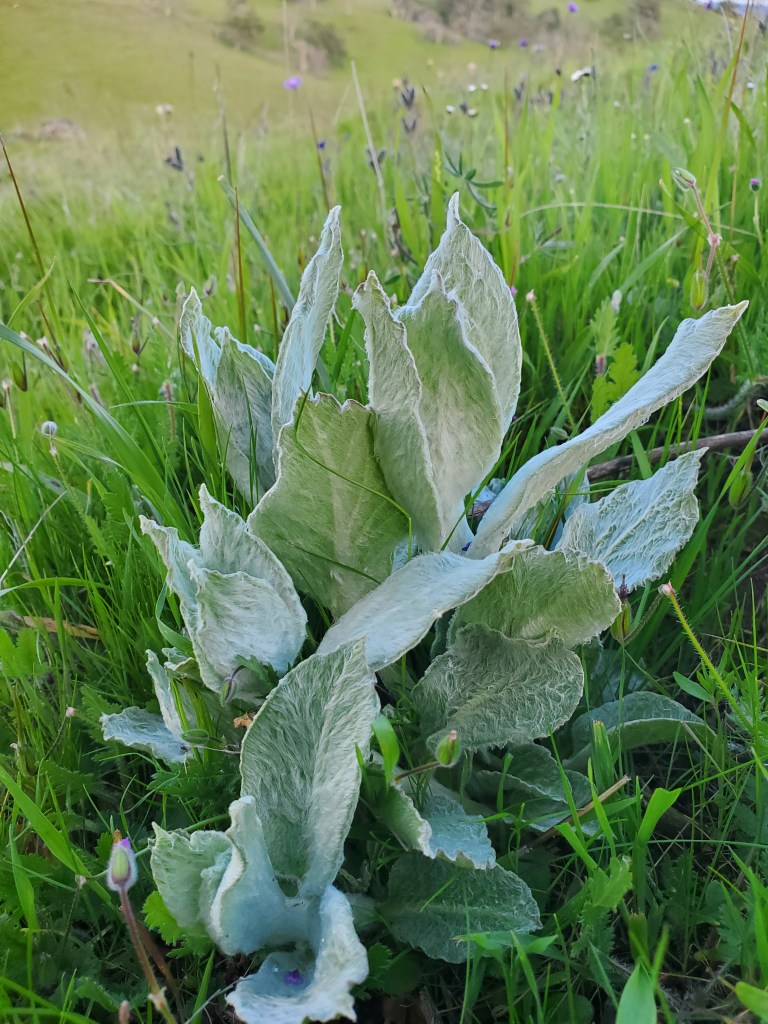
One thing I have learned is that these plants are resilient and fast growers when the conditions are right. There are two large mature plants that can be egg-laying sites for monarchs. Remember, monarchs are choosy. They like to lay eggs on plants that are more mature, so there is sufficient food for their brood. There are others still emerged and growing. The rain and cool temps have slowed them, but it has also slowed the migration of the monarchs. It has given special time for the crotch bumble bee to make a meal of the emerging flowers before more hungry competition arrives. Then, the other plants, impacted but not dead will bloom and sprout, replacing the leaves and stems of the earlier sprouted mature plants after they are eaten by ravenous caterpillars. There is a wonderful balance to everything, and I have, we all have, our roles.


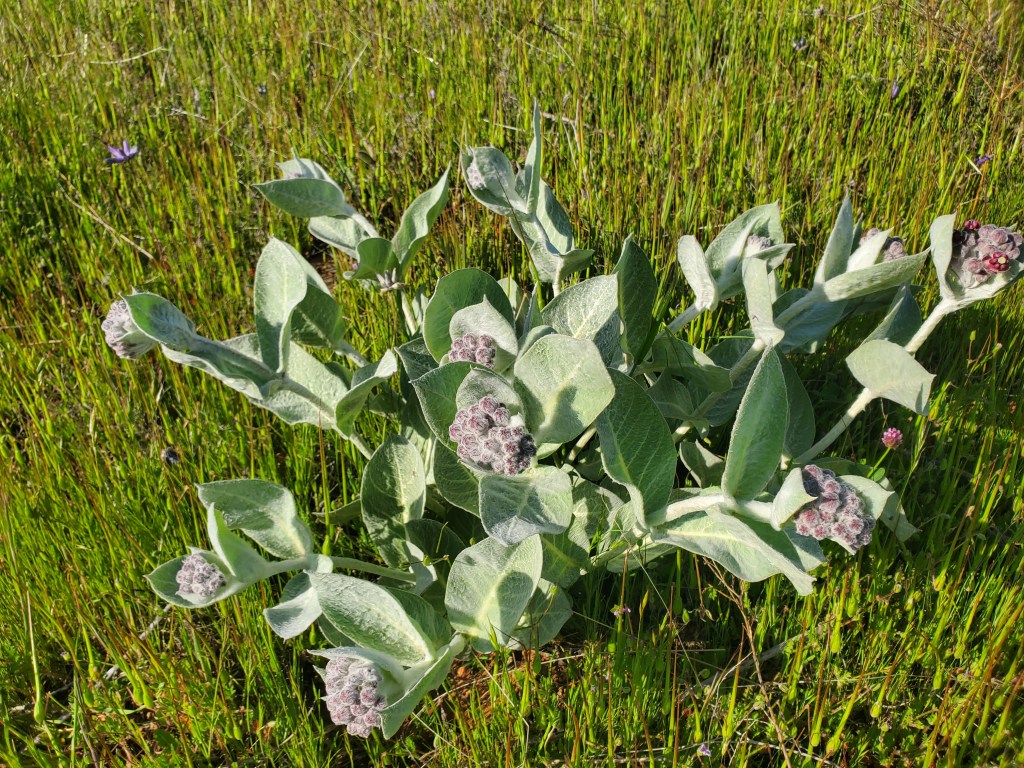
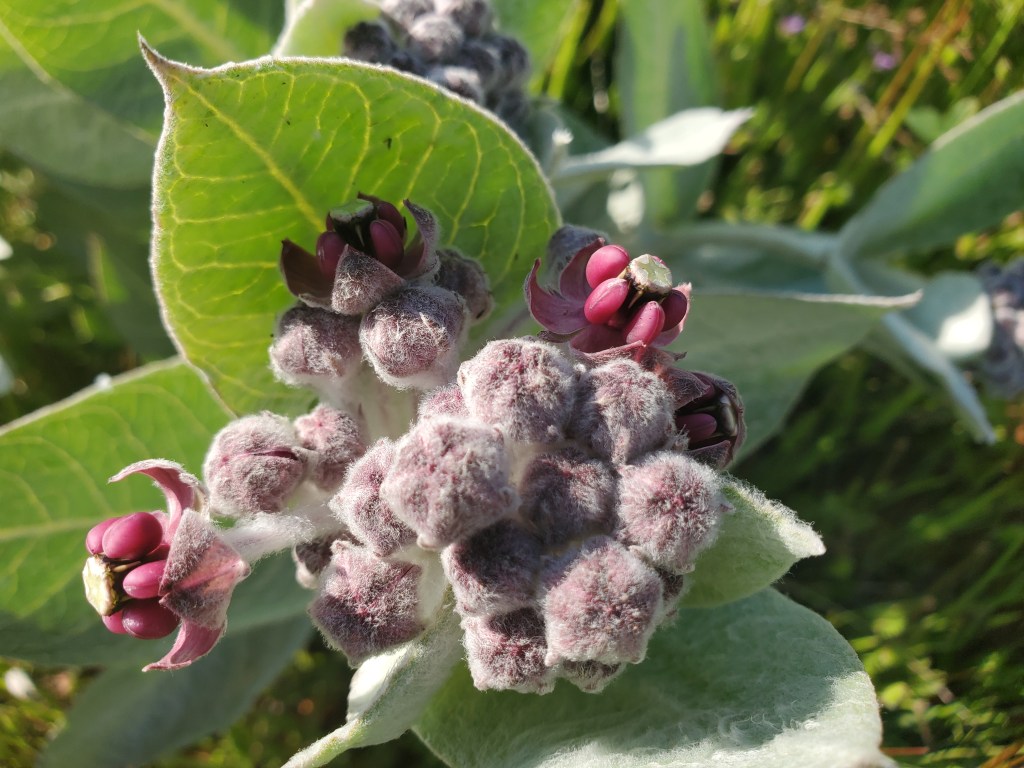
Education
Giving and receiving is how balance is created. You learn. You try. You teach what you learn from trying. I have shared how remarkable Shana, the Southern Sierra Miwuk Nation Pollinator Program Coordinator, is. She has a natural affinity and relationship with plants. The tribe has been doing a great job of offering cultural education classes for tribal members and other Indigenous residents. A couple weeks ago, Shana was a presenter on plant propagation at an Indigenous botany class. She presented with Jeanette Acosta who discussed the uses of pine. It was an outstanding program. Shana and Jeanette did a great job, and I learned so much. It is wonderful to see her learning and teaching.


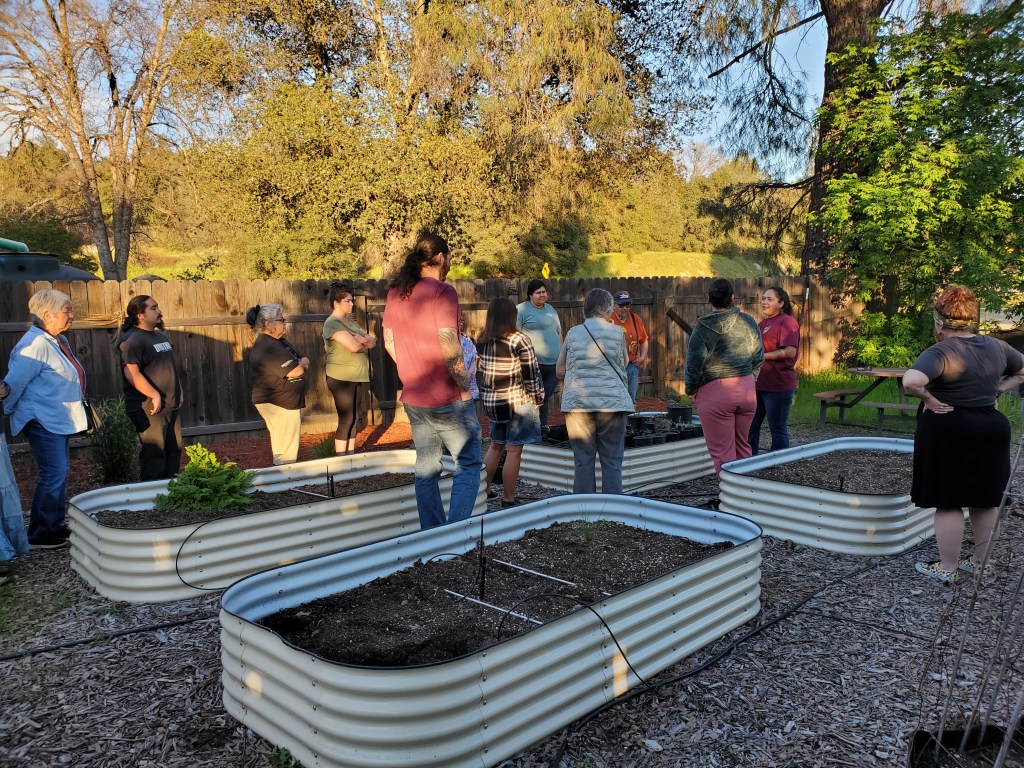
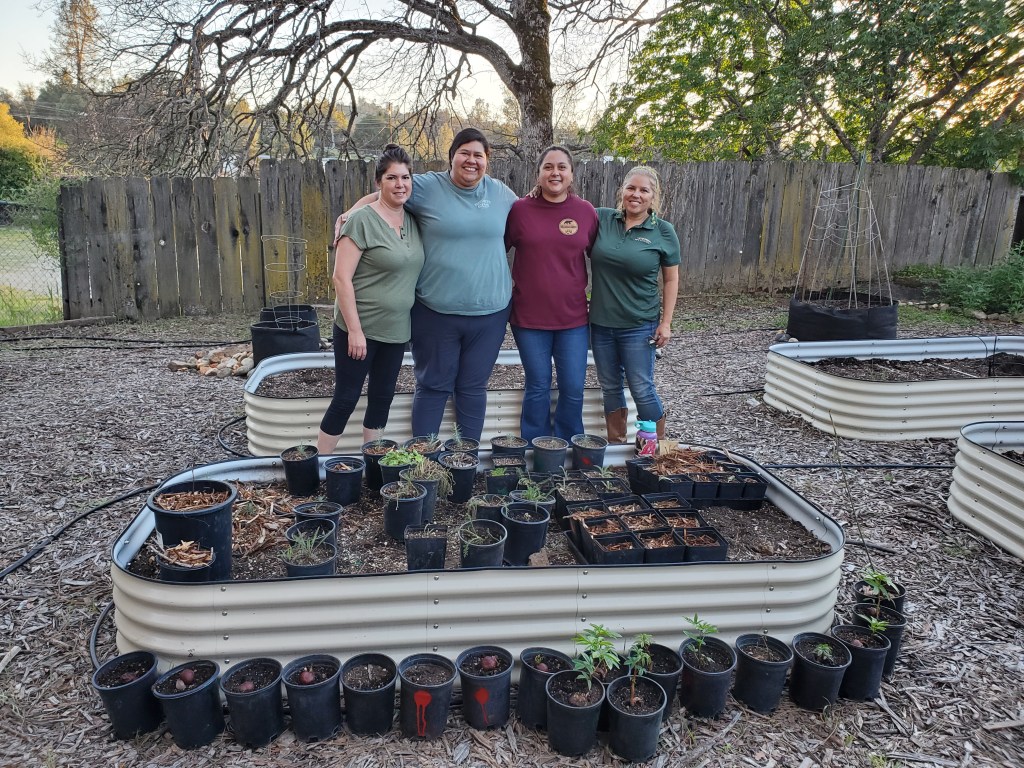
A group of us also attended a workshop at UC Davis on traditional tule stewardship and its relation with limiting bug-borne diseases. It was fascinating. The presenters were Diana Almendariz, Maidu-Wintun natural and cultural history expert, and Geoffrey M. Attardo PhD, professor at UC Davis. It was one of the best presentations I have ever been to – a Sunday well-spent!
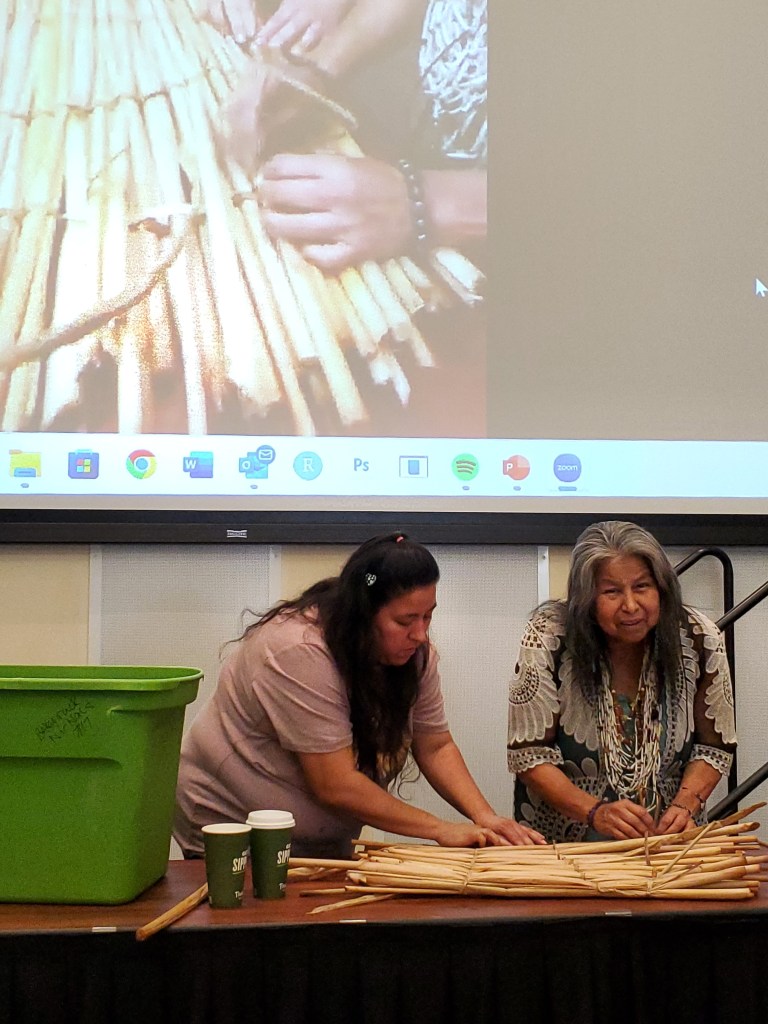
This month, Shana and I will be attending a tribal pollinator co-management workshop in Santa Fe where we will learn and share. It was a tremendous honor to be invited to contribute and connect. I am looking forward to learning and building a larger network of stewards across the land. I have an additional trip to Santa Fe for a restoration workshop. We will be learning from Santa Rosa Pueblo people and others about their stewardship work and learning through helping.
Frogs, Toads, Birds, Bumbles and Butterflies
There is so much wildlife. The small brownish-white butterflies are all over the wildflowers. I saw the first painted lady, a pair actually, yesterday. There are more large bumble bees around than I have seen in over a decade. They are flying from flower to flower and then directly at me, sending me the message that I need to leave their food zone. I try to get a photo before I heed their wishes, but they are moving too fast. I leave and go back to my office to work. The songs of hundreds of birds blend beautifully each day outside my office window. Adding to their chorus are the chirps of frogs, toads and grasshoppers. The music is joyful. Chiokoe uttesiavu weweriam (Thank you relatives)!
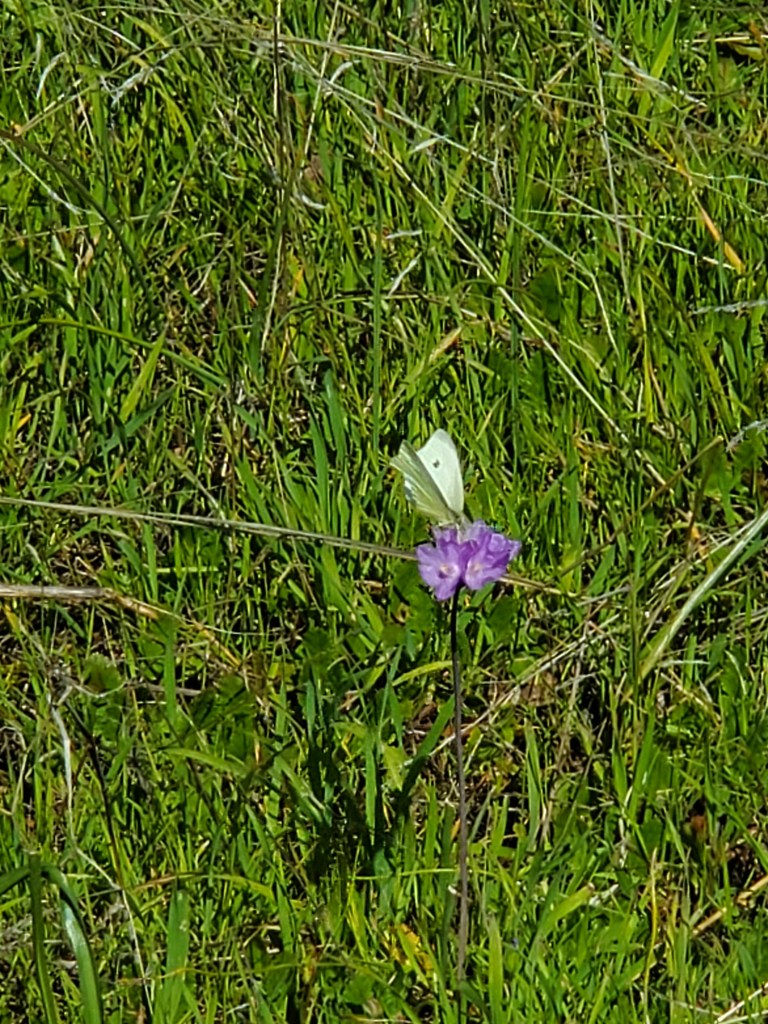
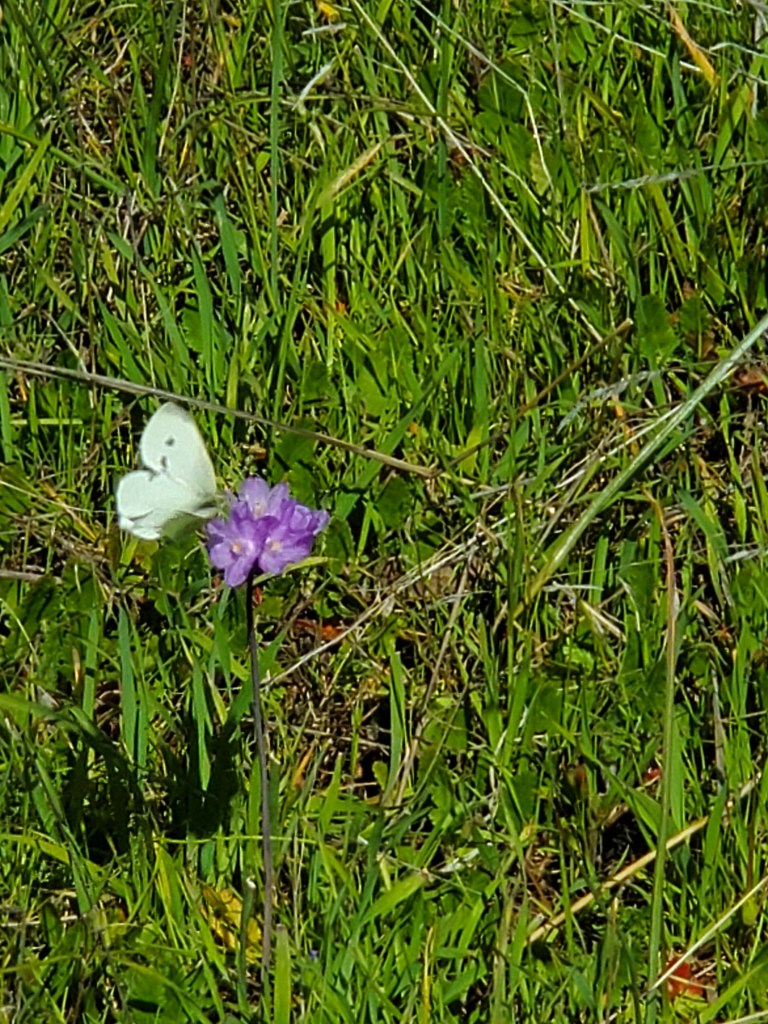

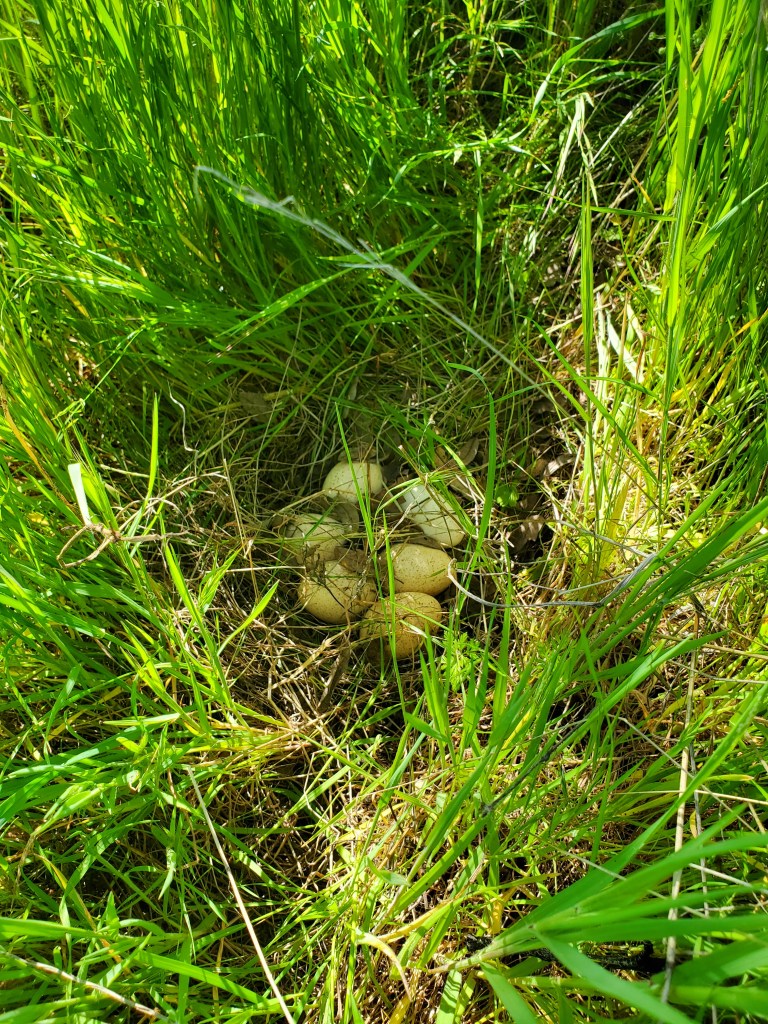


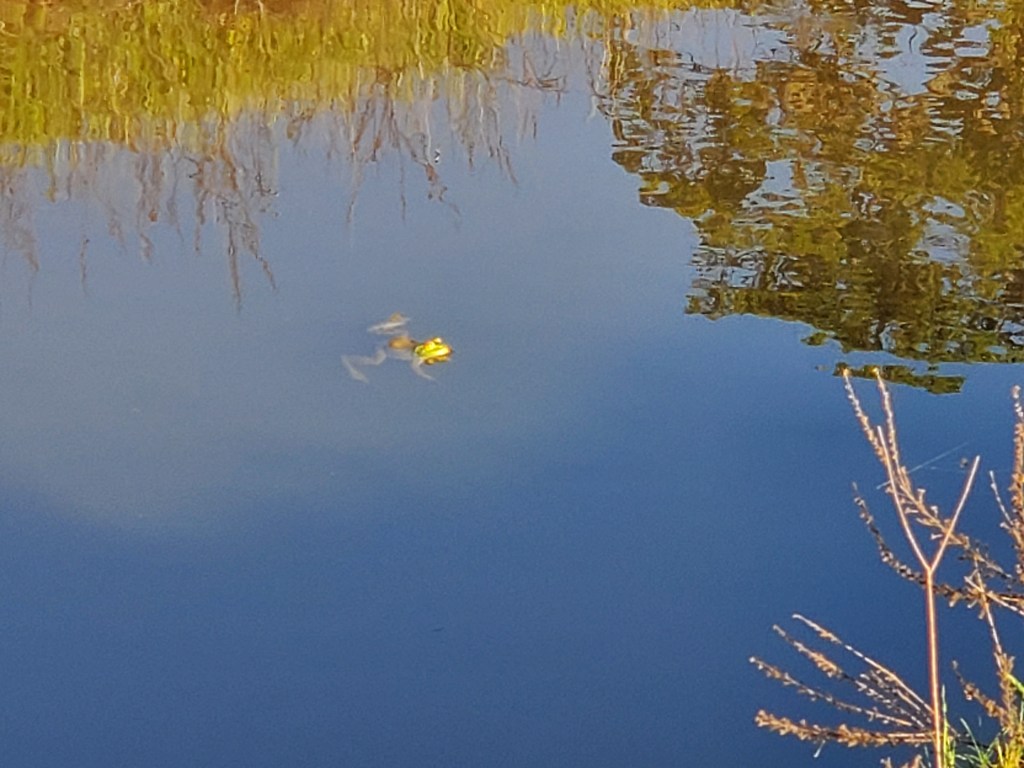
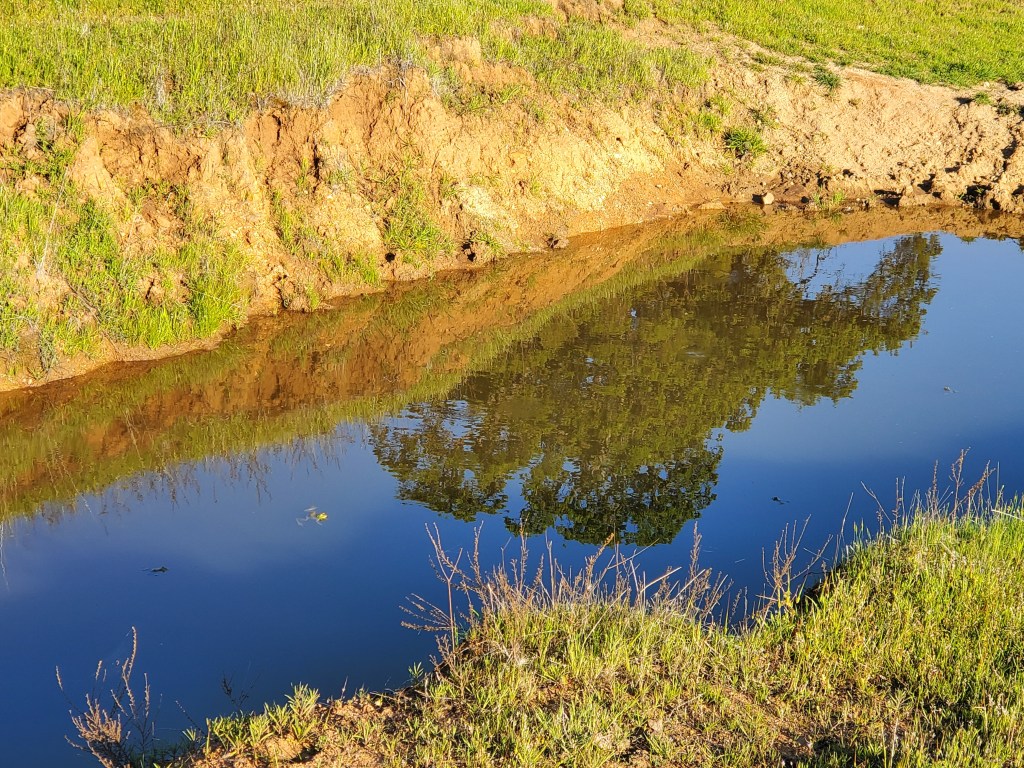

Wildflowers Abound
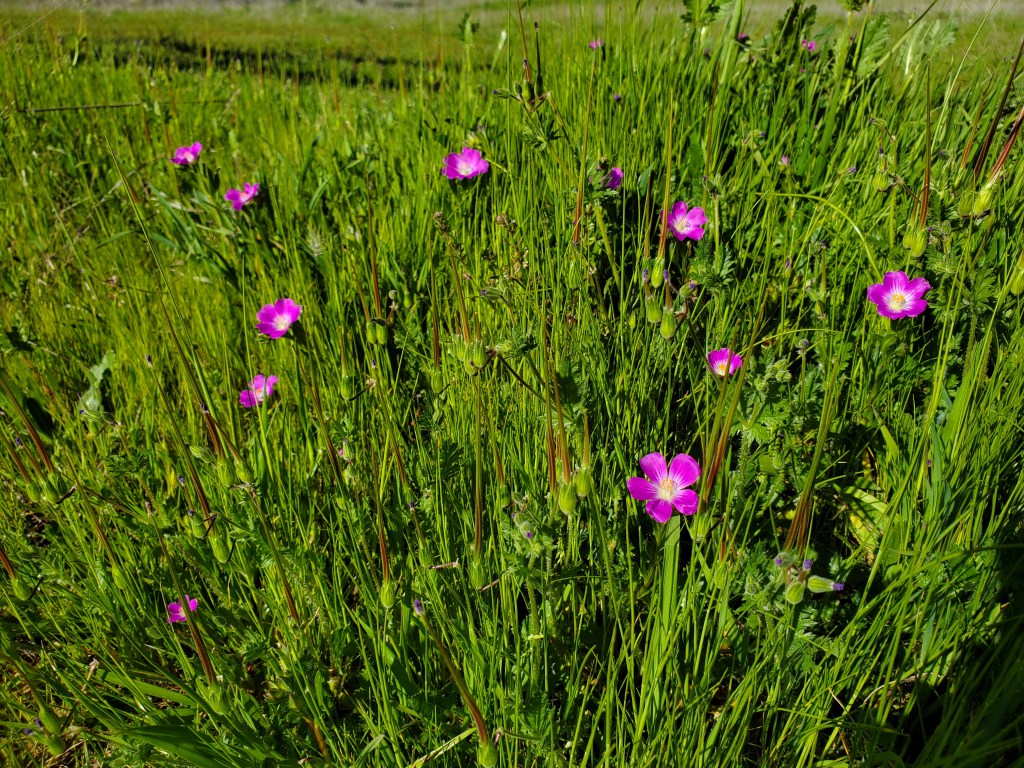



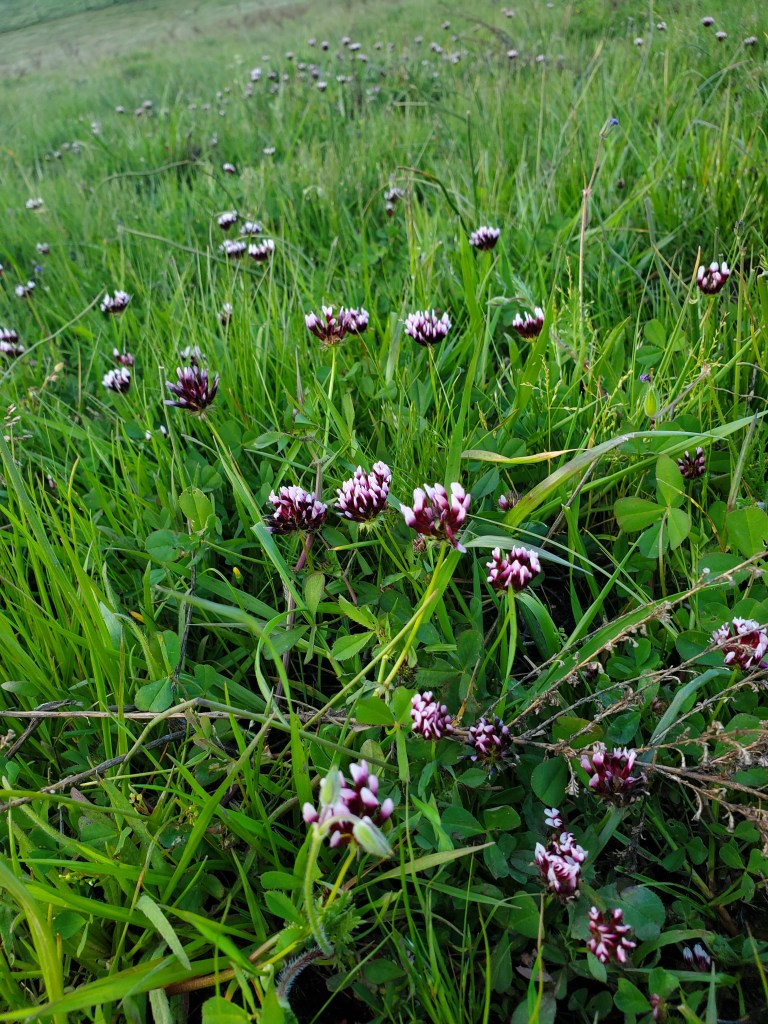
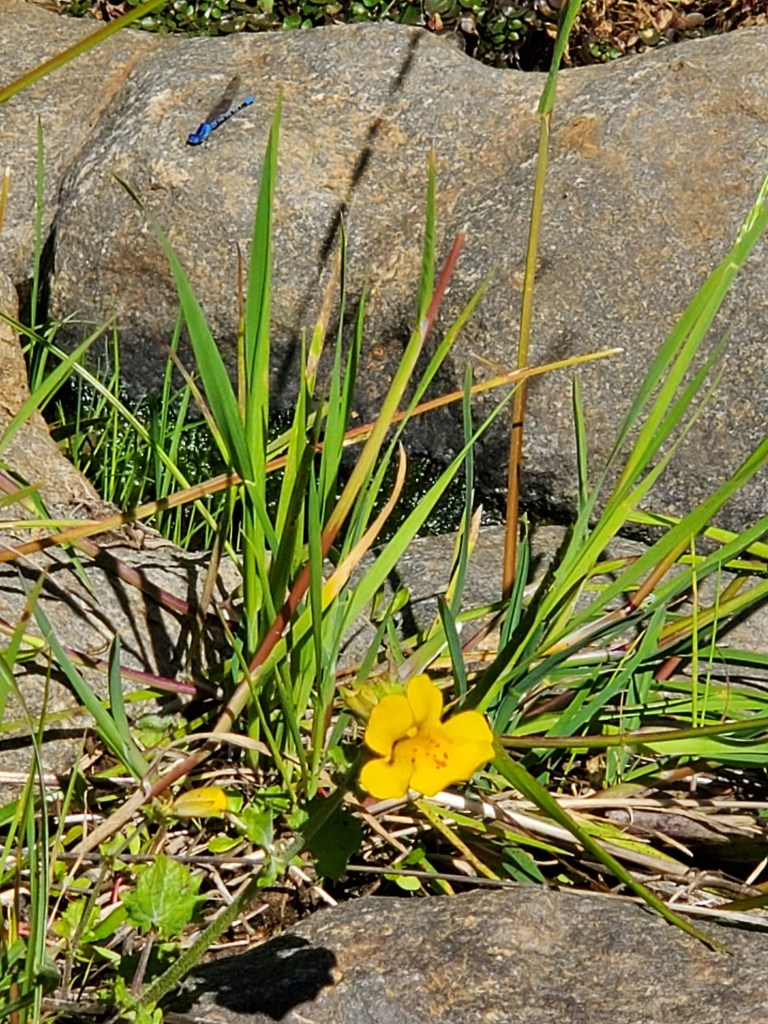


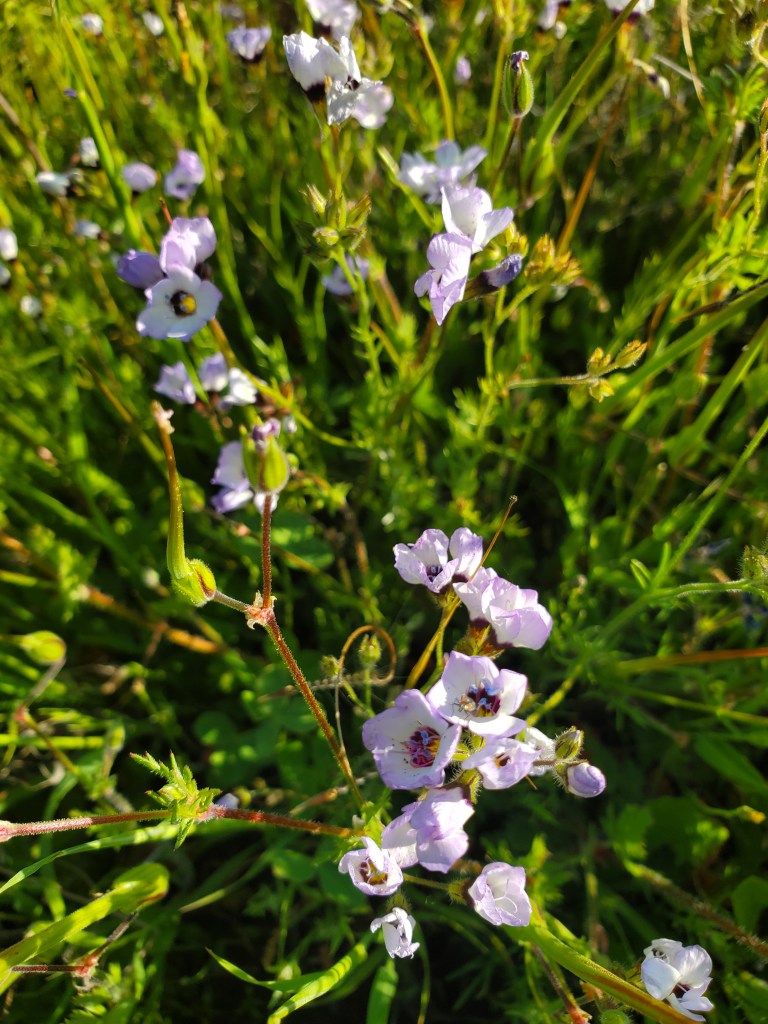
These flowers are a lifeline for so many creatures. They are only possible because of water. So far, we have had just over 16″ of rain, spread well over the rain year, not in a few big gushers. This is just above average precipitation for Hornitos, and follows an abundant rain year. It has been pleasant to see this “normal” distribution of moisture, growth and blooming. I was concerned the milkweed and other flowers might be damaged by last weeks cold storm. They weren’t. We did not get snow, but the snow was close to our elevation making for beautiful views. I would have loved a snow storm like last year in January or February. Snow helps slow things down and distribute water slowly.

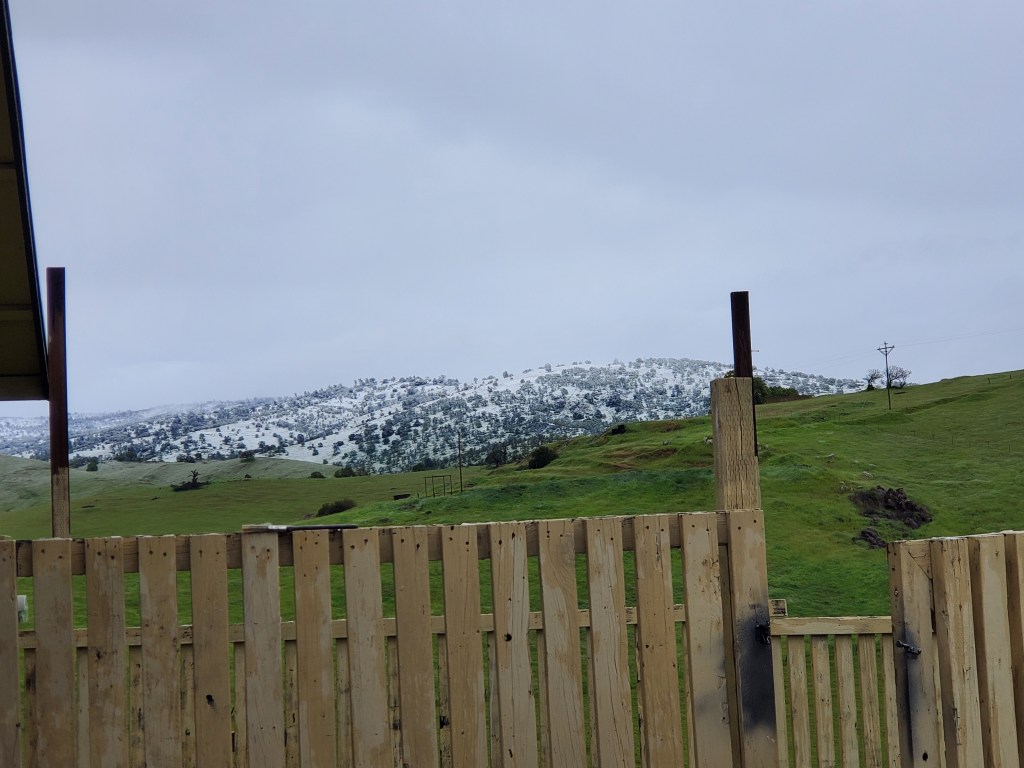
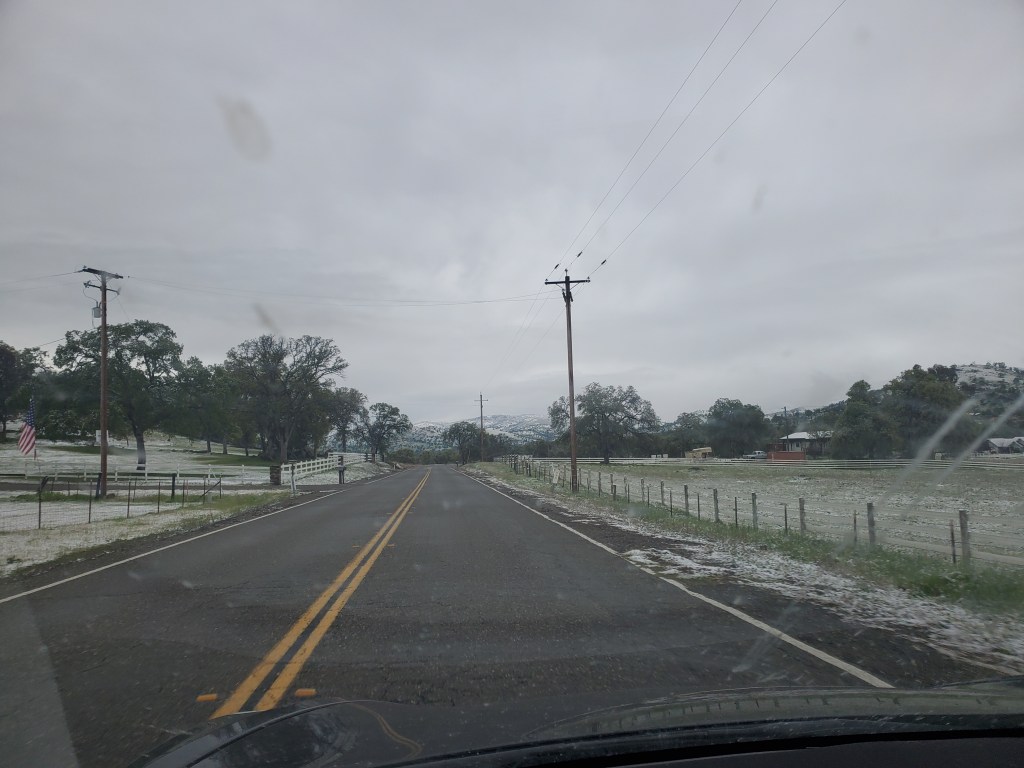
More Oaks Planted
My mother-in-laws were visiting again, which provided a wonderful opportunity for another set of hands to plant the oak trees. We planted four together along the drainages. Although I use the existing pattern of oak trees as a guide for where to plant, I am concerned that the soil in one of the drainages is a little too clay-like. One of the biologists once told me that trees can change an entire system if they take root by bringing up moisture, shading soil with their canopy and bringing more types of life to an area. Everything I do is an experiment based on logic and observation. The plants and land know where they can survive, where they should be. My role is to help them survive by watering during their initial first two years of life in a changing climate. If they make it through, my role then becomes one of monitoring and maintenance.
While oak planting, I also brought dried elderberry seed to plant. Last year, I gathered elderberry from an old grove near the Tuolumne River to help the Southern Sierra Miwuk have enough stock for an elderberry syrup making class and for elders. I saved a little for me and dried some seed for planting this year. We will see if there is enough moisture to make this plant happy. I planted them near the small spring.


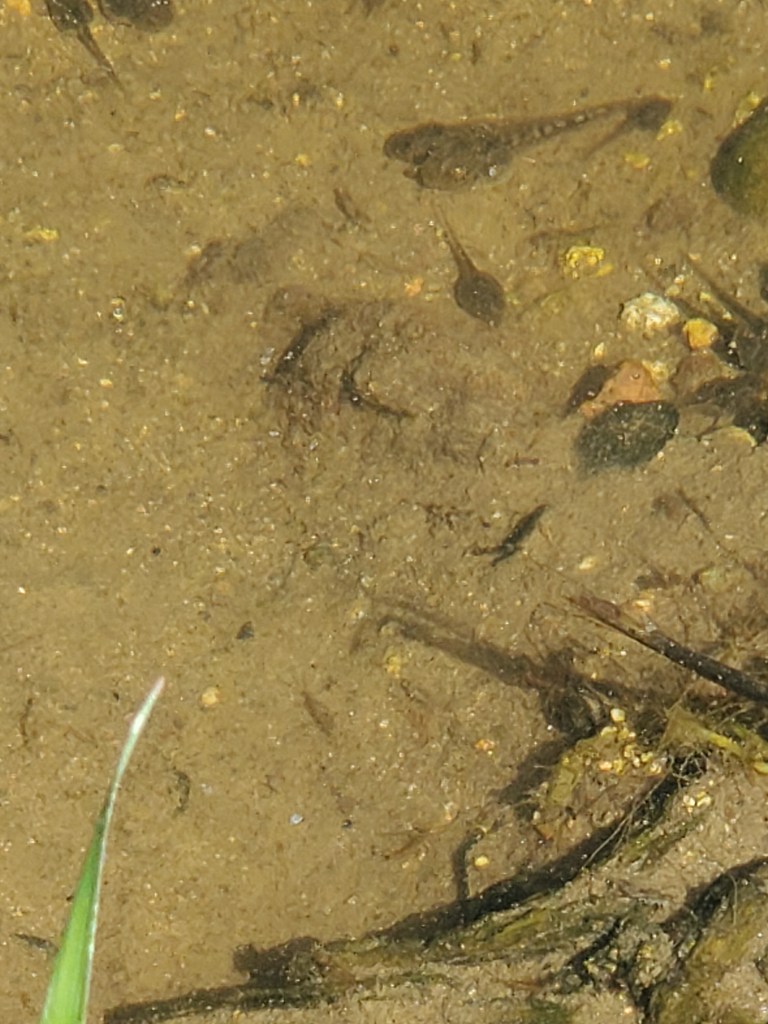
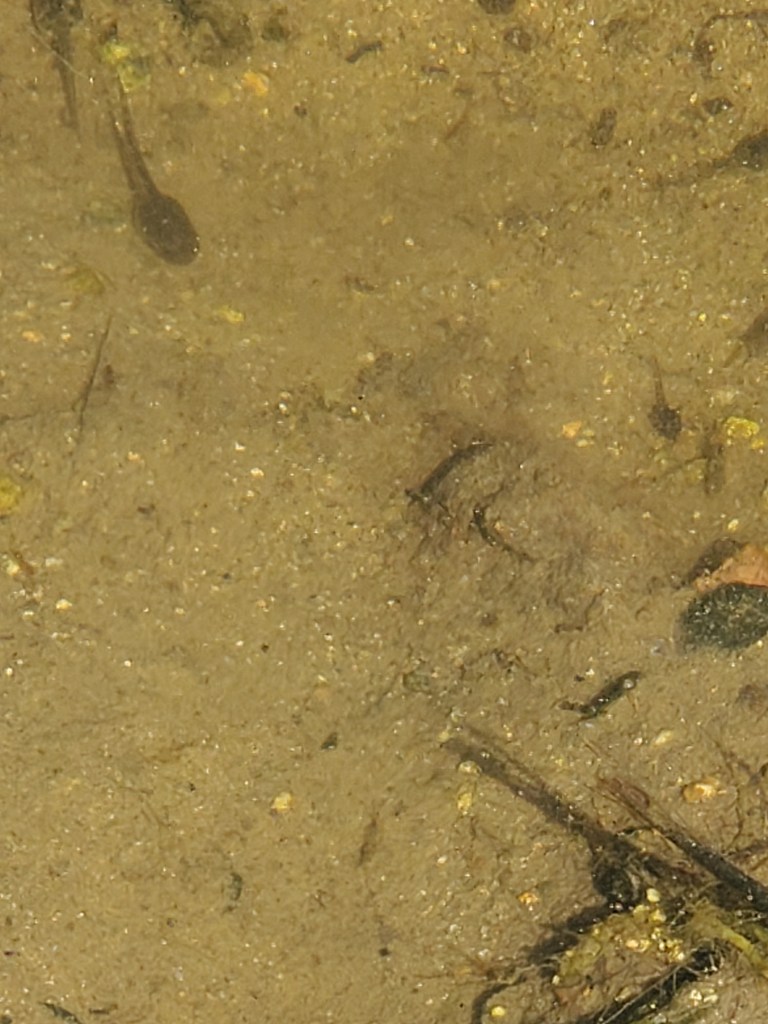

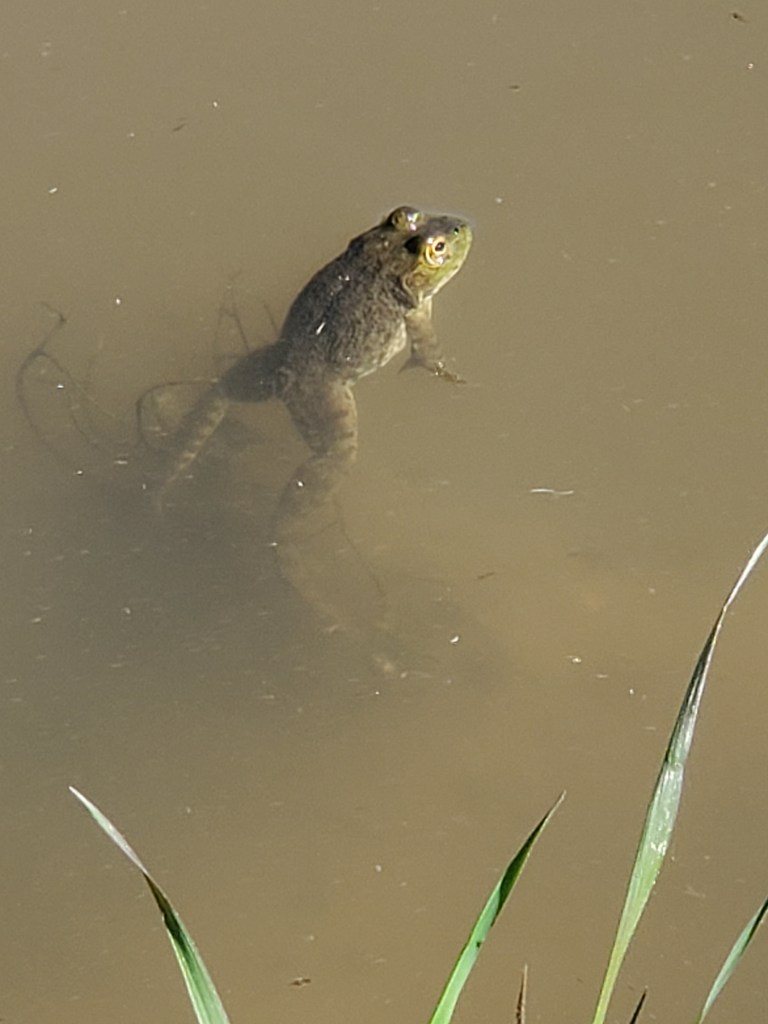


My 99th Post!
Whew – 99. I am on the edge of triple digits. The next post will be a celebration and reflection. I continue to be astonished by this journey, the wonderful plants, animals, insects, amphibians and humans that I meet. It has been a huge amount of work, but I am grateful everyday for this opportunity to steward – even if my back, shoulders, feet, legs and arms are sore. It is worth every ice pack!
